In December 2017, Congress passed a $1.5 trillion tax cut and reform package that became the subject of heated, partisan politicking.REF Three years later, the Tax Cuts and Jobs Act (TCJA) is the subject of countless lingering mischaracterizations. Much of the law is temporary; major provisions begin to expire on January 1, 2023, with the largest automatic tax increases arriving in 2026. Setting the record straight for lawmakers and the American people is crucial to ensuring that Congress keeps taxes low and makes the TCJA reforms permanent. Reversing the tax cuts would make the COVID-19 economic recovery more challenging by increasing the cost of rebuilding a strong labor market that benefits American workers.
The tax cuts’ most important legacy is their benefits for American workers at every income level. In the years after the reform, the labor market improved, resulting in annual wages of more than $1,400 above trend, business investment increased, and the economy expanded. The individual tax cuts benefited more than 80 percent of Americans, and some of the largest reductions in tax bills accrued to the lowest-income Americans. Changes to the state and local tax (SALT) deduction and mortgage interest deductions (MID) did not negatively affect middle-class taxpayers, devastate the housing market, or reduce trends in charitable giving.
The lowered 21 percent corporate income tax rate and other reforms made American businesses and the millions of American workers they employ more competitive. However, the U.S. corporate tax rate is still higher than most of the United States’ largest trading partners. The law was not expected to pay for itself over the 10-year budget window, but tax cuts are also not the cause of the systemic budget deficit. Mandatory spending growth for Social Security and health care entitlements drives budget unsustainability.REF
Following are 12 myths about the TCJA and explanations to set the record straight.
Myth #1: It was “Just” a Tax Cut
When deciding on a name for the 2017 bill, President Donald Trump notably wanted to call it the “Cut Cut Cut Act.”REF This sentiment is reflected in common references to the “2017 tax cuts,” “Trump’s tax cuts,” or the “GOP tax cuts.” While the bill did include a significant tax cut for most Americans, and lowered average tax rates for every income group, it was also the most significant reform to many parts of the tax code in 30 years—since the Reagan-era 1986 tax reform. The TCJA made it easier for millions of Americans to pay their taxes, simplified family benefits, and overhauled the international tax system, among many other reforms.REF
Here are some of the most significant changes in the law. The TCJA:
- Lowered individual income tax rates and thresholds.
- Nearly doubled standard deductions of $12,000 for single filers, $24,000 for married couples filing jointly, and $18,000 for head of household filers in 2018.
- Repealed all personal and dependent exemptions.
- Doubled the child tax credit to $2,000. The phase-out threshold for the tax credit for married joint filers increased from $110,000 to $400,000. The refundable portion of the credit increased from $1,000 to $1,400. The TCJA also added a new $500 non-child dependent credit.
- Included a new $10,000 cap on the state and local tax deduction and a $250,000 reduction (to $750,000) to the cap on the mortgage interest deduction for new mortgages. The phase-out of itemized deductions (Pease limitation) is eliminated along with other smaller itemized deductions.
- Increased the alternative minimum tax (AMT) exemption from $86,200 to $109,400 for married filers. The new exemption phases out starting at $1 million, up from $164,100.
- Lowered the federal corporate income tax rate to 21 percent, down from 35 percent.
- Expanded full expensing for business investments with asset class lives of 20 years or fewer.
- Added a new 20 percent deduction for certain non-salary pass-through business income. The deduction phases out for certain service providers with incomes that exceed $157,000 for single filers and $315,000 for married couples filing jointly.
- Repealed the domestic production activities deduction and overhauled the international tax rules.
Each of the changes for individuals expire after December 31, 2025. Business expensing begins to phase out after December 31, 2022.
These changes made it easier for most individuals to pay taxes each year. Under the TCJA, the number of people who were able to complete their own tax returns in 2018 increased by 4 percent.REF The Tax Foundation estimated that the simplifications would save Americans between $3 billion and $5 billion in compliance costs.REF For most Americans, the most significant simplification is the larger standard deduction, paired with SALT and MID reductions. The percentage of taxpayers who use the more complicated system of itemizing their tax deductions decreased from 30 percent to 10 percent between 2017 and 2018.REF
The reforms also simplified family tax benefits by eliminating the personal and dependent tax exemption and expanding the child tax credit to compensate. A larger AMT exemption means that thousands of higher-income taxpayers are no longer subject to the overly complicated parallel tax system.
Business taxes were simplified by eliminating the corporate AMT, expanding business expensing, and eliminating the domestic production activities deduction. However, the law’s 20 percent deduction for privately owned pass-through businesses adds significant complications and perverse incentives to the tax code.REF As described under Myth #s 8 and 9, the international tax rules were also almost entirely rewritten, creating a break from the previous regime. While these changes were not a simplification, they do represent an important structural reform to the tax code.
Myth #2: The Tax Cuts Benefited Corporations, Not Workers or the Economy
The 2017 business tax cuts have been widely maligned as contrary to workers’ interests and a detriment to the economy.REF In reality, the corporate tax cut supported jobs and wage growth. There are clear indications that the TCJA succeeded in allowing new business investment, which is a key component of how the law is intended to support a strong labor market and a bigger economy. For a more comprehensive review, see The Heritage Foundation Backgrounder “An Economic History of the Tax Cuts and Jobs Act.”REF
Critics often point to lackluster business investment trends toward the end of 2019 to claim that the law did not boost domestic investment. However, following the tax cuts, business investment increased by more than government scorekeepers predicted and remained above their pre-reform forecasts through the end of 2019.REF Other measures, such as new manufacturer orders, small business plans to expand, and new business applications, showed significant improvements in early 2018.REF Some of these gains were undermined by trade uncertainty and costly tariffs through 2019.
In 2018 and 2019, the labor market also improved significantly. A significant increase in wage growth marked the beginning of 2018. Chart 1 shows that nominal year-over-year average hourly earnings had declined slowly through 2016 and 2017, averaging 2.4 percent. Following the tax cuts, wage growth for production and nonsupervisory workers increased to 3.8 percent by October of 2019. Because of these gains, the average production and nonsupervisory worker received $1,406 in above-trend annualized earnings in March 2020. There was also a significant and sustained increase in job availability and job mobility after 2017. Other measures of real wages, unexpected bonuses, paid family leave policies, and better retirement benefits show similar positive bounces in the years after tax reform.
Myth #3: The TCJA Was Only a Tax Cut for the Rich
Many Americans believe that they are not benefiting from the tax cuts because it was widely reported that the reform primarily benefited corporations and the wealthy.REF This narrative is highly misleading.
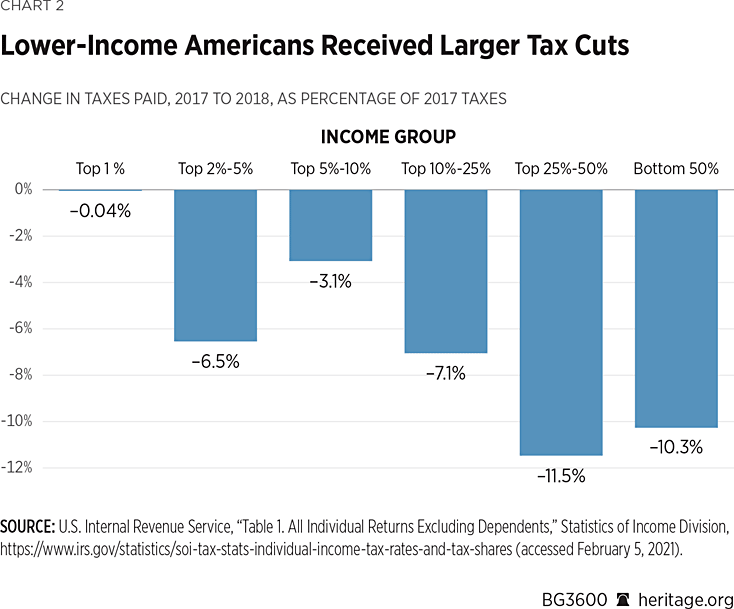
In October 2020, the IRS released its final report on taxes paid by income group in the 2018 tax year (the first year for which people paid taxes under the TCJA regime). The data in Chart 2 show that the tax cuts as a percentage of taxes paid in 2017 were largest for the lowest-income Americans and smallest for the top 1 percent, measured by adjusted gross income (AGI). Similarly, the percentage decrease in effective tax rates was about 5 percent for the highest-income group, and 16 percent for the half of Americans whose income is below the median. After the TCJA, higher-income taxpayers now pay a larger share of all taxes. By this metric, the income tax system was made more progressive. The top 1 percent of taxpayers paid 40 percent of income taxes in 2018, and 38 percent in 2017.REF
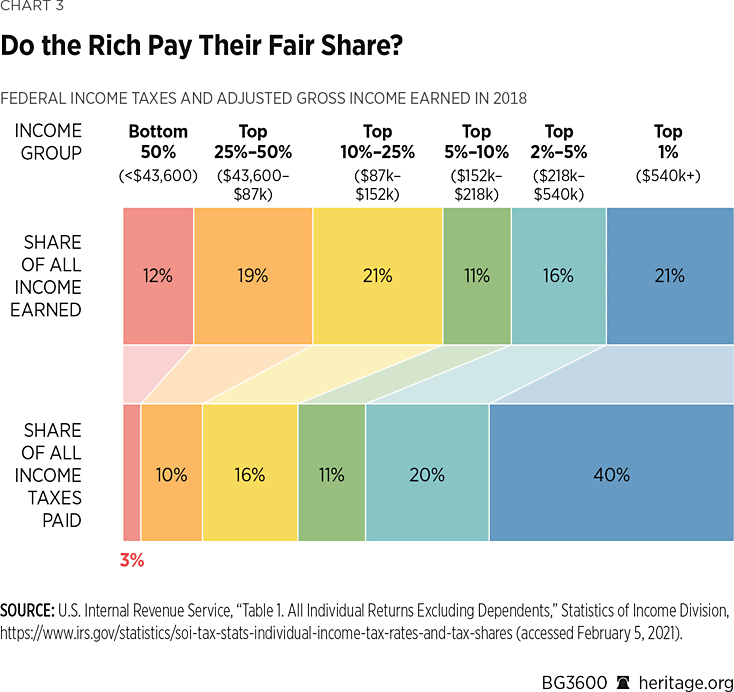
Critics of the law point out that the dollar value of the total tax cut and the tax cut as a percentage of income are skewed toward higher-income taxpayers. This is simply a mathematical fact of most any reform that attempts to cut marginal tax rates for all income groups. The latest IRS data in Chart 3 show that in 2018, the top 1 percent of income earners—those who earned more than $540,000—earned 21 percent of all U.S. income while paying 40 percent of all federal income taxes. The top 10 percent earned 48 percent of all income and paid 71 percent of all federal income taxes. Those who pay the most taxes and pay the highest effective tax rates will also see commensurate benefits when rates are lowered. This does not mean that middle-class Americans were left out of the reforms.
Of the $1.5 trillion bill, 78 percent ($1.1 trillion) of the total tax cut was for individual taxpayers.REF Corporations received a $329 billion tax cut, but even these changes benefited workers. Workers primarily pay the cost of the corporate income tax through lower wages. Economic estimates typically show that labor bears between 75 percent and 100 percent of the corporate tax’s revenue cost.REF As shown in Myth #2, cutting business taxes benefited working Americans.REF
Myth #4: Most People Did Not Get a Tax Cut
Americans who think they did not get a tax cut in 2018 are in good company. Only 17 percent of Americans surveyed in a 2019 NBC News/Wall Street Journal poll thought their taxes would go down because of the TCJA.REF After more than a year of misleading reporting about the tax reform, even The New York Times admitted, “Face It: You (Probably) Got a Tax Cut.”REF
More than nine of 10 taxpayers received a tax cut or saw no change because of the TCJA. According to the left-leaning Tax Policy Center, only 4.8 percent of taxpayers were projected to see a tax increase, and 80 percent benefited from a tax cut.REF After filing taxes, IRS data confirm that Americans in every income group benefited from lower effective tax rates, as shown in Chart 4. Average effective tax rates declined by 9.3 percent (about 1.4 percentage points) in 2018.REF
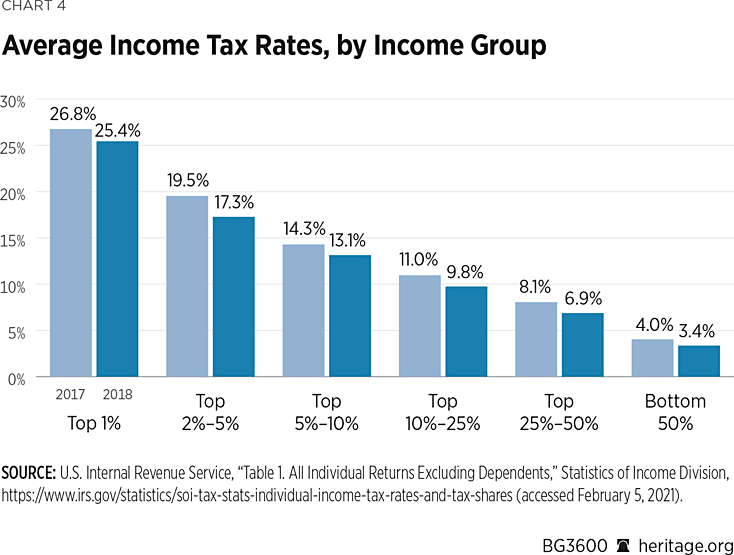
Myth #5: The SALT Cap Increased Taxes on the Middle Class
The TCJA included a $10,000 cap on the deduction for state and local taxes (SALT), which is available to taxpayers who itemize their tax deductions—instead of selecting the now larger standard deduction. Before 2018, 70 percent of taxpayers received no benefit from the SALT deduction. Those who did claim the credit tended to be wealthy taxpayers in high-tax states.REF Even the high-income taxpayers who face the new SALT limit likely still got a tax cut for three reasons.
First, the tax law doubled the standard deduction, which means that about half the people who previously chose to itemize their taxes now voluntarily decided to take the new larger standard deduction. Most of these people are better off than they were before. Second, tax rates were lowered across the board. Even if taxable income increased slightly because of the SALT cap, lower tax rates mean most people still came out ahead. Third, because the tax law raised the exemption for the AMT, millions of higher-income AMT-paying taxpayers saw the SALT deduction increase from zero to $10,000 under the TCJA because they no longer have to pay the AMT, which disallows the SALT deduction.REF
Capping the SALT deduction was a good reform. The SALT deduction creates the largest subsidy for high-income taxpayers in high-tax states, paid for by the rest of Americans. Before the TCJA cap, a taxpayer in New York making between $50,000 and $75,000 a year deducted on average $3,375 worth of SALT from his federal taxable income. A taxpayer in Tennessee, making the same income, only deducted $924 on average, which increased his federal taxes by about $400 compared to his identical New York counterpart. These middle-class taxpayers are unlikely to be affected by the new SALT cap.
The disparity among high-income taxpayers was even larger: The average millionaire living in New York or California deducted more than $450,000 worth of SALT; the average millionaire in Texas deducted only $50,000 and therefore paid close to $180,000 more per year in federal taxes. These high-income taxpayers are likely limited by the new SALT cap but benefited from other changes in the tax code.
Repealing the SALT cap in isolation, as proposed by congressional Democrats and a few Republicans, would be a $500 billion tax cut almost exclusively for the top 20 percent of income earners. About 60 percent of the benefit—a roughly $300 billion windfall—would go to the highest-income 1 percent of households making $755,000 and up.REF If Congress wants to reduce taxes for the highest-income earners, lowering the top marginal tax rate would be far more equitable and efficient, as it would stimulate economic growth instead of stimulating higher state and local taxes.
Myth #6: Limits on Itemized Deductions Reduced Charitable Giving
It was widely predicted that the TCJA would reduce charitable giving by limiting the tax incentive to donate.REF Expanding the standard deduction and limiting other itemized deductions (such as SALT and MID) means that about 28 million fewer taxpayers itemized their taxes in 2018. Because the deduction for charitable contributions is an itemized deduction, more people now receive no tax benefit from charitable giving.REF The tax benefit from giving also decreases when tax rates fall.
The data in Chart 5 indicate that charitable giving increased following the tax cuts. In 2017, individuals’ real charitable giving increased by 8 percent, from $279 billion in 2016 to $302 billion in 2017. A portion of this increase represents people artificially moving some of their planned 2018 donations into the 2017 tax year to take advantage of the higher tax rates. Deductions are worth more when tax rates are higher.
The timing shift of donations led to a small 2 percent drop in 2018 giving compared to 2017, but still a 6 percent increase over 2016 giving in real, inflation-adjusted dollars. In 2019, charitable giving resumed its increasing trend, jumping by 8 percent from 2018, and 11 percent from 2016.REF Corporate giving also increased, following similar trends.REF
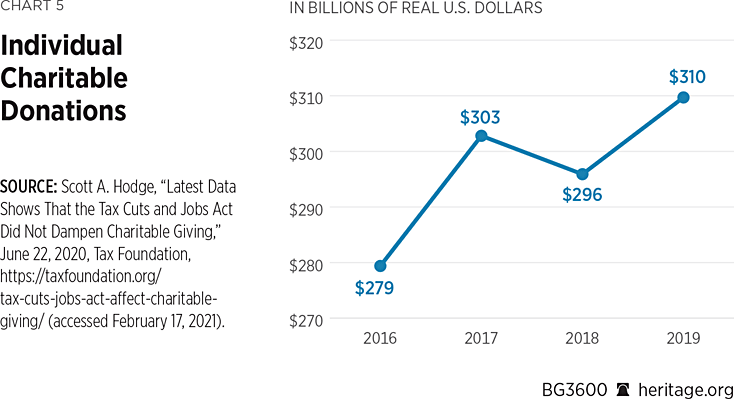
Tax benefits are not the reason why most Americans donate to charity. Less than 40 percent of Americans who donate to charity write it off on their taxes.REF Religious conviction, care for others, and dedication to community are much stronger incentives to give than the incentives in the tax code. People also tend to give more when they feel wealthier, and people feel wealthier in good economic times, which tend to follow pro-growth tax reform.
Myth #7: Reducing the Mortgage Interest Deduction Would Devastate Home Prices
In 2017, a report commissioned by the National Association of Realtors projected that a reform to the MID similar to the one ultimately passed in the TCJA would decrease housing prices by between 8 percent and 12 percent in the short run.REF Instead, housing prices increased at an average annual rate of 5.5 percent in the two years after the reform.
The TCJA reduced the maximum mortgage balance eligible for the MID by $250,000 to $750,000 for new debt incurred after December 15, 2017.REF In addition to the SALT cap and larger standard deduction, the smaller MID substantially reduced new homeowners’ reliance on the tax preference. The MID and the SALT deduction act as a relative subsidy for owner-occupied housing.REF
In the first eight months after the law passed, the Zillow Home Value Index’s nominal year-over-year growth rate remained almost constant at 6.6 percent.REF In 2018 and 2019, the positive growth rate for home values never dipped below 3.7 percent. Across three other indices, real housing prices also increased through 2018.REF Chart 6 shows that although the growth rate slowed slightly, the overall price level continued to increase after the 2017 reforms. The slowdown was more pronounced in high-income population centers. In these places, home prices had risen faster than wages for multiple years, and the deceleration likely had “little to do with the tax law,” according to an economist at Zillow.REF Homeownership rates also continued to increase in the years following the reform.REF
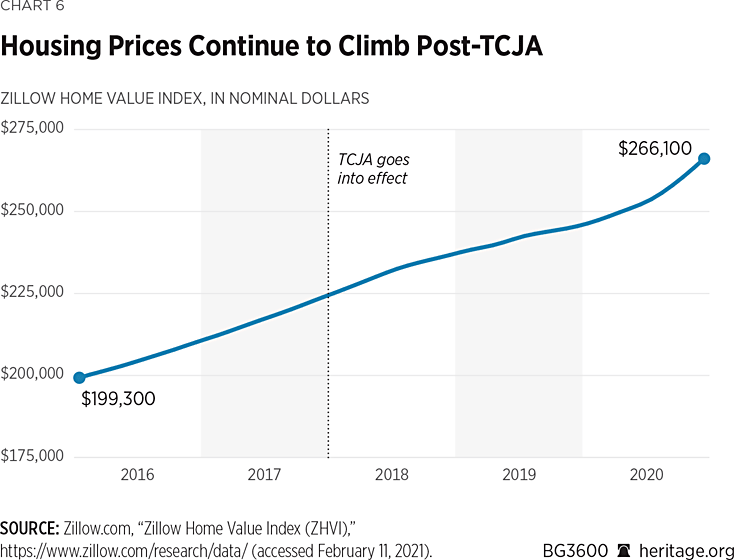
These trends should not be surprising. Research generally finds that the MID does not increase rates of homeownership. Empirical investigations typically conclude that the deduction’s primary effect is that it enables higher-income families to take on larger debts and thus purchase homes 10 percent to 20 percent larger than they would buy without the tax benefit.REF Any downward price pressure from the new limits would therefore be felt only at the very top end of the market.
Myth #8: The Corporate Tax Cut Hurt Workers by Increasing Stock Buybacks
In 2018, publicly traded corporations increased “stock buybacks”—a maneuver that allows the business to repurchase its own stock at market value from current investors. These routine actions were quickly used as evidence that corporate America was paying out investors instead of reinvesting in their workers and other core functions.REF This analysis misrepresents the economics of share repurchases and misses the effects of changes to the international tax system.
When a firm repurchases its stock, the transaction does not make the shareholders wealthier. It is merely a voluntary transfer of cash for the value of the stock. In this regard, a stock buyback is no different from a dividend payment. In both transactions, the business pays out part of its profit to the firm’s owners (the shareholders).REF Rather than removing resources for workers, it frees up resources to be better deployed, hiring workers and expanding investment in new and under-invested industries.
Stock buybacks and dividend payments are typically more extensive when the business does not have suitable investment options for all its profits, so it gives part of the profit back to their investors to reinvest in other, more productive endeavors.REF For example, at the same time that stock buybacks were peaking, the U.S. venture capital industry—which invests in some of the most innovative start-up firms in the world—saw a $78 billion increase in assets under management, the largest single-year jump reported.REF It is likely that some of the capital being returned to investors through stock buybacks ended up fueling an increase in venture capital funding and other similar investments.
Corporate stock buybacks in the S&P 500 Index increased in 2018 by about $350 billion over their previous trend, totaling $800 billion. Buybacks remained elevated in 2019. The one-time spike was primarily driven by firms that repatriated funds previously held by a foreign affiliate. The pre-TCJA system incentivized multinational firms to hold profits overseas as a way to delay U.S. taxes on profits not earned in the U.S. The TCJA moved the U.S. tax code from a “worldwide system” toward a territorial system that no longer tries to tax all overseas profits. After these changes, U.S. businesses repatriated more than $1 trillion above their previous trends. (See Chart 7.)REF Research from the Federal Reserve shows that firms with larger overseas holdings were significantly more likely to buy back shares in 2018. Similar trends were found in 2004 after a temporary change allowed firms to bring foreign funds home.REF
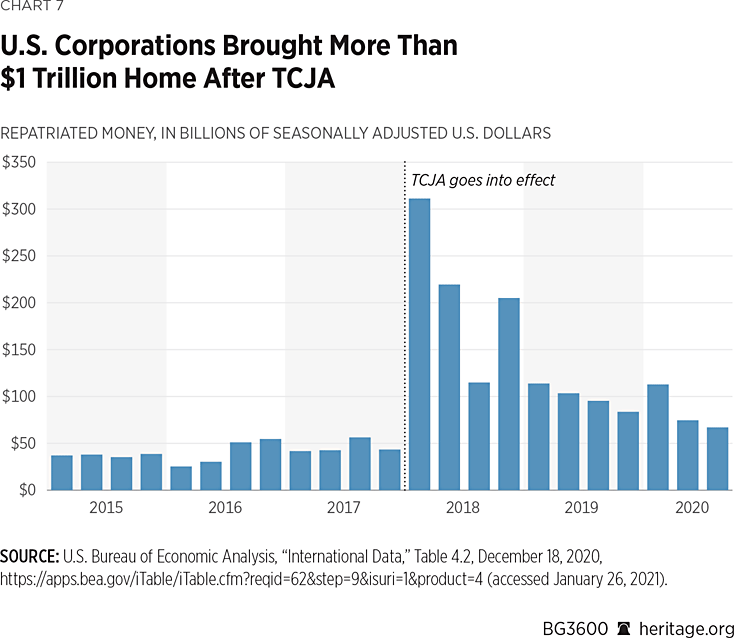
The large spike in repatriated funds is primarily an accounting change and not a shift in any real activity. Repatriated earnings are commonly misunderstood as newly available funds for U.S. investment. However, most multinational firms were able to access profits held overseas through international debt and capital markets. Accessing these funds still came with real frictions, which increase the cost of accessing foreign-booked profits more for some firms than for others, depending on business structure and access to external financing. Firms with higher costs for accessing foreign cash were more likely to increase stock buybacks after the TCJA.REF This relationship indicates that these one-time rebalancing actions likely benefited domestic workers and investors by lowering the costs of accessing foreign cash for some firms.
Myth #9: The TCJA Rewards Companies that Offshore Jobs
Campaigning in Warren, Michigan, candidate Joe Biden claimed that the tax cuts rewarded “companies that sent production and jobs overseas,” repeating a common claim about the reform.REF However, in 2018 and 2019, available jobs and wage growth performed better than before the reforms, especially for production and nonsupervisory workers.
Corporate taxes on multinational businesses are levied based on highly complex rules. Given this complexity, critics like to pick out one narrow component of the TCJA reform and critique its impacts without accounting for the myriad other offsetting changes. When investigated holistically, the TCJA unambiguously benefits American workers. Chart 8 shows that available job openings increased by more than 1 million, from an average of 6 million in 2016 and 2017 to 7.5 million at the end of 2018, which was an unprecedented 1.4 million more jobs than the number of unemployed workers.REF The decline at the end of 2019 happened concurrently to increasing tariffs and other trade frictions that likely cost well over a million jobs.REF
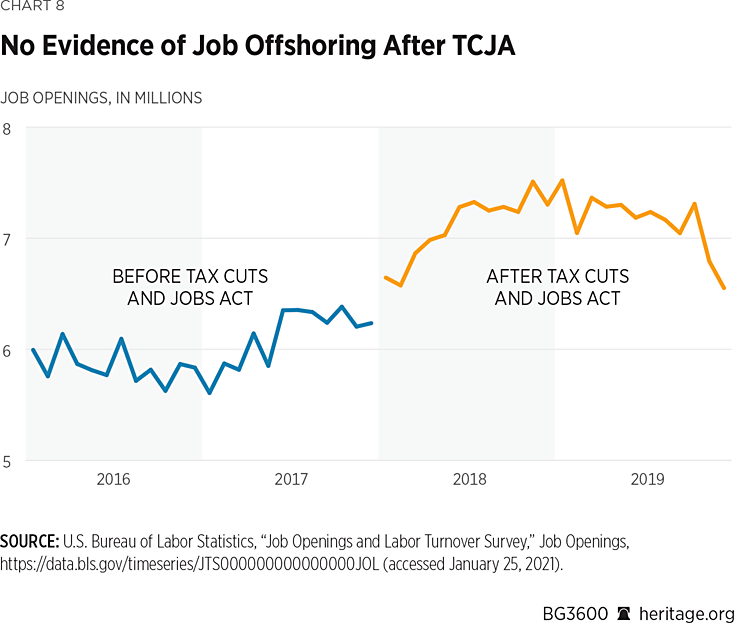
The TCJA abandoned the outdated worldwide international tax system for a new quasi-territorial regime. The previous worldwide system applied an internationally high 35 percent federal corporate tax rate to all U.S.-headquartered firms’ profits, no matter where the profits were earned. The tax was only due when the profits were repatriated to the U.S., creating large tax deferrals on profits held overseas. This system created an incentive for U.S. firms to acquire foreign firms and move their legal residence, and sometimes physical production, out of the U.S. The U.S. was one of just six Organization for Economic Co-operation and Development (OECD) countries with such a penalizing worldwide tax system.REF
In principle, the new quasi-territorial system only taxes corporate income earned in the U.S., but it includes a series of three new, complex international levies to maintain U.S. taxing rights on highly mobile income.REFCritics point to a dynamic in the new minimum tax that could be gamed by increasing tangible foreign property.REF While the new international system could be improved by further lowering U.S. taxes on domestic investment and fixing some perverse incentives in the new formulas, the existing law has offsetting reforms that encourage on-shoring and additional domestic investment. For example, in 2018, employment, capital expenditures, and R&D spending growth by U.S. parent companies outpaced that of foreign affiliates.REF
Studies have consistently found that the post-TCJA regime reduced firms’ incentive to move their headquarters overseas by acquiring foreign firms in a maneuver called an “inversion.” One of President Biden’s Treasury nominees found that similar incentives against artificial profit-shifting have increased the base of corporate profits subject to tax by the U.S., an incentive counter to the claim that firms moved jobs overseas.REF An analysis of different types of investments by multinational firms found that the U.S. is now a more attractive location for intangible investments and did not significantly change the incentive for tangible assets.REF The incentives for U.S. firms are important, but foreign-headquartered firms also have new incentives to invest in the U.S.REF In addition to the international rules, lower tax rates and full business expensing have reduced incentives to move physical production, jobs, and business income overseas.
Myth #10: The 21 Percent Corporate Tax Rate Is Lower than Necessary
The TCJA permanently lowered the federal corporate income tax rate to 21 percent in 2018. A key campaign pledge made by candidate Biden and congressional Democrats in 2020 is to raise the rate to 28 percent.REF Before the tax cut, the U.S. levied one of the world’s highest corporate income tax rates. The high rate made it more expensive to invest or expand in America. Instead, businesses moved their headquarters overseas and chose lower-tax countries for their new projects.
In 2017, the federal corporate tax rate was 35 percent, and the federal–state combined rate was 39 percent. Forty U.S. states have a corporate income tax, with rates that range from 11.5 percent in New Jersey to 2.5 percent in North Carolina.REF In the years leading up to 2017, U.S. headquartered corporations faced the highest statutory tax rate in the developed world. The U.S. was also consistently ranked one of the least competitive tax environments by several other measures of marginal, effective, and average tax rates.REF
A 21 percent federal corporate tax rate was the upper bound for global tax competitiveness. Chart 9 shows that among the OECD—a group of America’s international peers—the U.S. still has a combined corporate tax rate that is two percentage points higher than the non-U.S. international average. In 2020, 25 OECD member countries, including Denmark, Norway, and Sweden, had corporate tax rates lower than the U.S.REF
Other countries realize that a competitive business tax rate is an essential domestic policy. Given this dynamic, Congress should work to further lower, rather than raise, the U.S. corporate tax rate. The corporate income tax should ultimately be eliminated, but a federal rate lower than Hungary’s 9 percent (the lowest in the OECD) would make America a leader in business tax rates and would benefit U.S. consumers, workers, and investors.
Raising the corporate tax rate would hurt U.S. competitiveness and make the U.S. a global leader again in punitive business tax rates. Raising the federal rate to President Biden’s proposed 28 percent (shown in Chart 9) would make American companies pay the highest tax rates in the developed world.
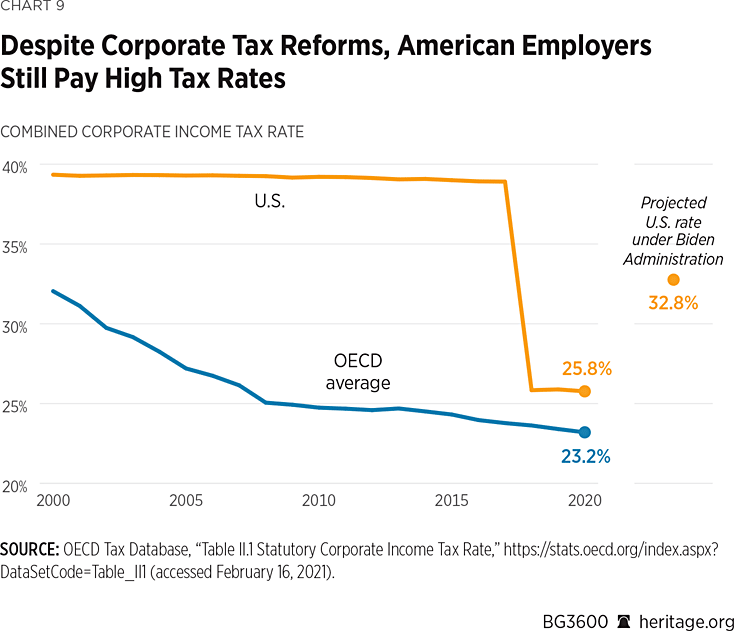
Myth #11: The Tax Cut Pays for Itself
President Donald Trump and other Administration officials often claimed that tax reform would pay for itself.REF This claim was misleading and distracted from the real purpose of the reform. The belief was rooted in the truth that the tax cuts would spur economic growth to help the Treasury recoup some lost revenue. However, over the conventional 10-year budget window, the tax cuts reduced net revenue and increased the deficit, even under optimistic growth scenarios. If Congress also curtails spending growth, lower revenue is precisely the goal of a tax cut. The purpose of cutting taxes is to allow Americans to keep more of their hard-earned money, not maximize revenue for the Treasury.
It is theoretically possible for a tax cut to increase economic growth or change taxpayers’ reporting behavior so that the reforms lead to a net increase in revenue. Especially over longer time horizons, a pro-growth tax cut can more easily recoup the initial lost revenue. According to a Tax Foundation estimate from 2017, the tax cuts would only reduce revenues temporarily. By 2024, due mainly to additional economic growth, the tax cuts begin to raise more yearly revenue than before the reform.REF However, breaking even in one year does not mean the additional $448 billion in projected new debt will be quickly paid down by a larger economy. If the tax cuts are made permanent, it is possible that during the second decade of the reform, the initial deficits could be recouped. However, this hypothetical assumes a materially different law than the one passed by Congress and an expanded budget window.
Myth #12: The Tax Cuts Caused the Federal Budget Deficit
Democrats and many Republicans rightly worried that the TCJA would contribute unnecessarily to the federal debt. However, claims that the tax cuts are responsible for the federal government’s poor fiscal health represent a misdiagnosis of trends that are decades in the making.
In June 2017, pre-TCJA, the CBO projected that the federal government would reach an annual budget deficit of $1 trillion in 2022.REF In April 2018, the CBO projected $1 trillion deficits arriving in 2020, showing the effects of the tax cuts and the 2018 budget deals, which increased federal spending by more than $500 billion in 2019.REF By this measure, the TCJA moved the trajectory of large and growing deficits up by between one year and two years.
The TCJA did increase the deficit, but the law is not the underlying cause of the unsustainable U.S. budget. The systemic gap between revenues and expenditures is driven by sustained growth in mandatory spending programs since the 1970s.REF Chart 10 shows that the tax cuts, even if made permanent, only represent about 16 percent of the projected, non-pandemic-related 2021–2030 budget deficit forecast. Repealing the 2017 tax cuts would not change the trajectory of increasing federal deficits. Because the budget deficit is driven by spending growth and not lack of revenue, no politically viable tax increase can cover projected outlay growth.REF For example, one year’s deficit in 2030 is larger than the entire 10-year cost of the TCJA.
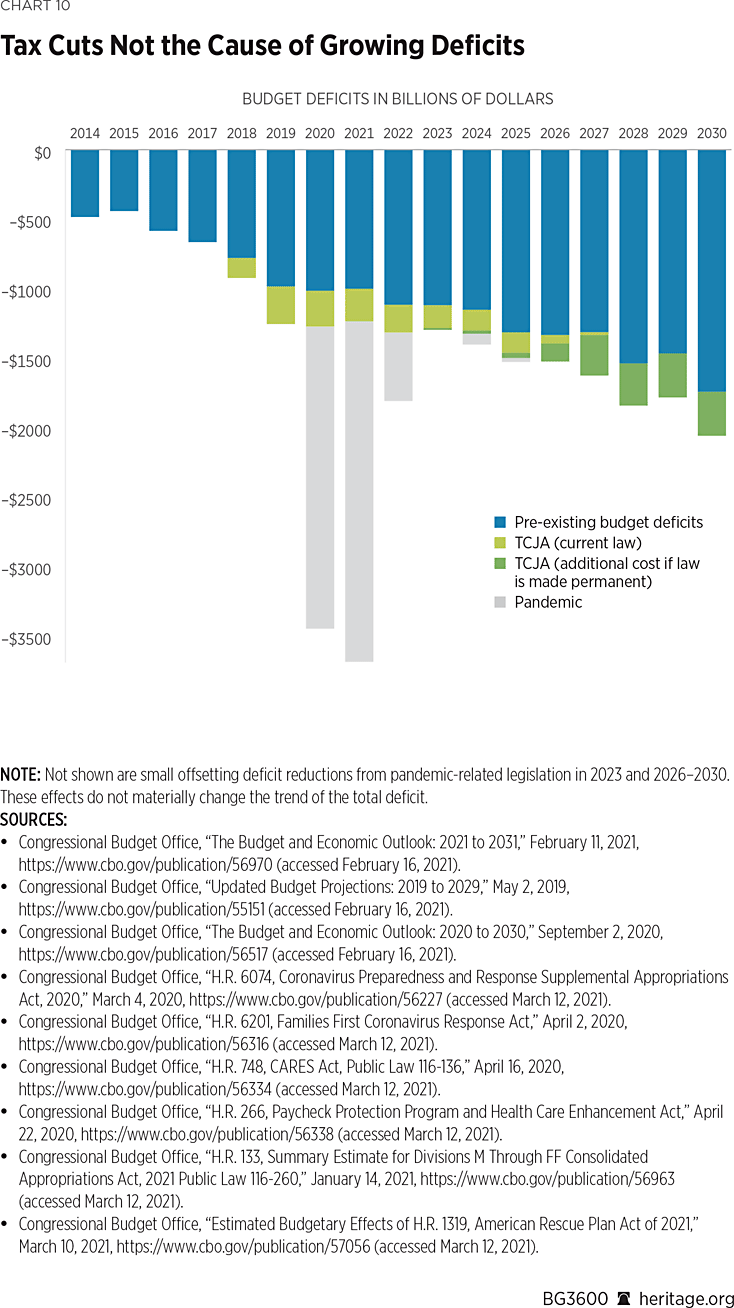
Regardless of the cause, congressional inability to constrain spending growth resulted in a deficit-financed tax cut, which was followed by spending increases rather than the necessary reforms. Keeping taxes low and restraining spending growth are mutually reinforcing goals.REF Without spending reform, today’s lower taxes must result in higher taxes on future generations.
Conclusion
The 2017 tax cuts have likely made the COVID-19 economic crisis less severe, helping the economy to bridge the 2020 disruptions. While there is still a long way to go, the economy has consistently outperformed economic projections due in part to pro-growth policies put into place before the crisis.REF
First, the 2017 law boosted businesses’ available cash by cutting tax rates and allowing easier access to the $1 trillion in repatriated foreign profits. These and other reforms have likely given a large portion of the economy an extra cushion to draw on over the past year. Second, the structural reforms that encourage higher business investment levels do not go away in a pandemic.REF Because of lower business tax rates and business expensing, firms that are investing are investing a bit more than they would have otherwise. When the pandemic subsides, incentives to invest, hire, and expand will help propel the economic recovery.
In the coming years, Congress will need to preserve the TCJA’s gains. Beginning in 2023, the most pro-growth reform—full expensing—begins to phase out, and three years later, the rest of the tax cuts for individuals expire. Pressure from the political left and ballooning deficits are already threatening the gains from tax reform. Setting the record of the TCJA straight is crucial to ensuring that Congress chooses to keep taxes low and makes 2017 reforms permanent. Reversing the tax cuts would make the COVID-19 economic recovery that much more challenging.
Adam N. Michel, PhD, is Senior Policy Analyst for Fiscal Policy in the Grover M. Hermann Center for the Federal Budget, of the Institute for Economic Freedom, at The Heritage Foundation.